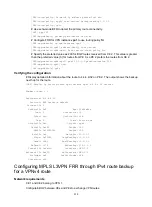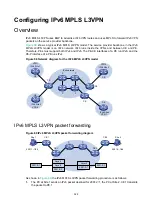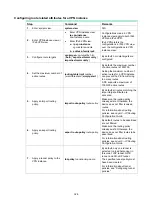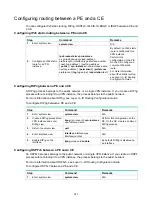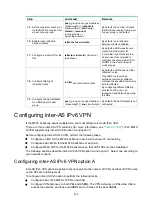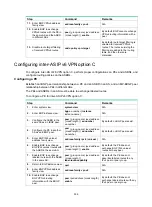
325
Creating a VPN instance
A VPN instance is a collection of the VPN membership and routing rules of its associated site. A VPN
instance might correspond to more than one VPN.
To create and configure a VPN instance:
Step Command
Remarks
1.
Enter system view.
system-view
N/A
2.
Create a VPN instance and
enter VPN instance view.
ip vpn-instance
vpn-instance-name
By default, no VPN instances
exist.
The maximum number of VPN
instances is 4095.
3.
Configure an RD for the VPN
instance.
route-distinguisher
route-distinguisher
By default, no RD is configured for
a VPN instance.
4.
(Optional.) Configure a
description for the VPN
instance.
description
text
By default, no description is
configured for a VPN instance.
The description should contain
the VPN instance's related
information, such as its
relationship with a certain VPN.
5.
(Optional.) Set an ID for the
VPN instance.
vpn-id
vpn-id
By default, no ID is configured for
a VPN instance.
6.
(Optional.) Configure an
SNMP context for the VPN
instance.
snmp context-name
context-name
By default, no SNMP context is
configured.
Associating a VPN instance with an interface
After creating and configuring a VPN instance, associate the VPN instance with the interface
connected to the CE.
If an interface is associated with a VSI or cross-connect, the association between the interface
(including its subinterfaces) and the VPN instance does not take effect.
If a subinterface is associated with a VSI or cross-connect, the association between the subinterface
and the VPN instance does not take effect.
To associate a VPN instance with an interface:
Step Command
Remarks
1.
Enter system view.
system-view
N/A
2.
Enter interface view.
interface
interface-type
interface-number
N/A
3.
Associate a VPN instance
with the interface.
ip binding vpn-instance
vpn-instance-name
By default, an interface is not
associated with a VPN instance
and belongs to the public network.
The
ip binding vpn-instance
command clears the IP address of
the interface. Therefore,
reconfigure an IP address for the
interface after configuring this
command.









